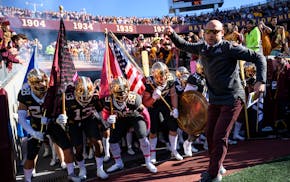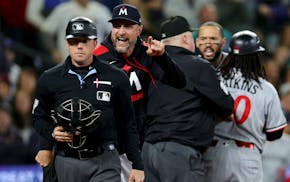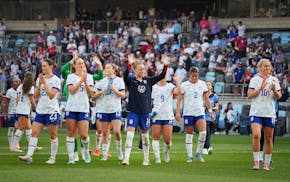Pro Football Reference's Approximate Value metric was created in an attempt to value the production of any player, at any position and from any NFL season, with a single number. Of the 1,035 players drafted from 2020 to 2023, 66 have produced at least one NFL season with an Approximate Value of 10 or more. Thirteen of those players are receivers; defensive back is the only other position group with as many.
Justin Jefferson, whose rookie contract was replaced this week by one worth $140 million over four years, is one of seven players with three such seasons, after the Vikings took him 22nd overall in 2020 with a pick they acquired for trading Stefon Diggs to Buffalo. The quick production of young receivers across the league could be used to advance the argument that, with such a surplus at the position, there's no need to pay a player like Jefferson the premium the Vikings agreed to give him.
When presented with that argument Tuesday, Vikings General Manager Kwesi Adofo-Mensah responded with a thesis on how the Vikings build their roster.
"I have been in places where they have specific calculations for how much a player's worth," he said. "Those are tougher in football as compared to baseball, just because of the interaction between teammates and things like that. But I do know those numbers, and obviously I have [them] in our calculations. And then you can kind of look at the market: What does the market typically pay for things like that? There's also ways to do it, relative value-wise: Would I rather have a quarterback at this level or a wide receiver at this level or a rusher at this level? But at the end of the day, studying teams that have gotten to the NFC Championship [Game], AFC Championship [Game], Super Bowl level, there's a certain amount of talent that it requires.
"How you get to that answer, there's a lot of different things: draft picks and different things like that. We try and compare, when we have to pay for premier players, what is that compared to other teams when they compare their players, and are we getting the right production out of that?"
The draft is the most efficient way to boost talent, Adofo-Mensah added, "but re-signing your own is typically the second best, right? Because then free agency is its own deal, and you have to pay a premium to the market. And then lastly is, people have to trade. So with that kind of hierarchy, we look at these deals as still pretty favorable to the team, when you're extending your own."
The Jefferson deal was the final bold stroke of an 85-day stretch that changed the foundation of the franchise. From March 11 to June 3, the Vikings:
• Let their starting quarterback and top pass rusher leave in free agency;
• Signed 14 unrestricted free agents, including a starting running back, three starting linebackers and a starting cornerback;
• Traded up to select a quarterback in the top 10 for the first time in franchise history;
• Traded up again to take a pass rusher in the first round for the first time since 2005;
• Made their top receiver the highest-paid nonquarterback in NFL history with a deal that includes nearly $70 million in cash through the first two years.
In dollars and draft picks, they paid dearly for players they hope can anchor the franchise. If it works, the Vikings might have given themselves a window for contention.
They now have players at three of the game's five most important positions (quarterback, pass rusher and wide receiver) under team control through 2028, with a contract extension for left tackle Christian Darrisaw possibly on the way. Even after signing J.J. McCarthy and Dallas Turner to their rookie deals, the Vikings will have about $21 million in available cap space for the rest of 2024, with the ability to add any unused cap space to the $50 million-plus they're expected to have in 2025.
Though Jefferson's deal includes a $36.94 million signing bonus and a $30 million option bonus in 2025, he'll count just $8.61 million against this year's cap and has only a $15.167 million number for 2025. His cap number jumps to nearly $39 million in 2026, before going to almost $44 million in 2027 and $47.49 million in 2028, but the Vikings included a void year at the end of the deal to help with a possible restructure, as they did with T.J. Hockenson's contract last year. They'll also be able to carry the deal's biggest cap charges before they have to pay McCarthy, whose cap number stays below $7 million through 2027 before his fifth-year option would hit in 2028. The cap numbers in the first four years of Turner's rookie deal would top out at $5.02 million in 2027 (before a fifth-year option).
Decisions on the futures of Jefferson, McCarthy, Turner, Hockenson, Jordan Addison and Jonathan Greenard arrive between 2027 and 2028. If McCarthy is successful, the Vikings could face the kind of choice the Packers faced between Aaron Rodgers and Davante Adams, or the Chiefs had between Patrick Mahomes and Tyreek Hill. But those decisions are far enough down the road not to concern the Vikings now. "You have two-year timelines; in the NFL, you probably can't plan any longer than that," Adofo-Mensah said.
When the GM was hired in 2022, he created a document with Kevin O'Connell to plan out their first two years together. Many of the Vikings' decisions, from the hard financial lines they took with veterans to the deals they made for Hockenson, McCarthy and Turner, seem to map out according to that plan.
"There's always that fine line, where you feel like you could have been a little better here or a little better there," Adofo-Mensah said. "But big picture, we've set ourselves up where I feel like we have a young roster where a lot of players are before their prime, or entering their prime at positions that matter. There are some other places where we have players that are developing and growing, and pieces that fit, complementary football-wise. And then in terms of our culture, I think we're building it the right way."
They will be judged on whether the calls they made on core pieces such as McCarthy and Turner were correct. Though Kirk Cousins' deal with Atlanta could net them a third-round compensatory pick, they currently have just three picks in 2025. They still have questions to answer on defense, particularly at cornerback, and they face a division well stocked with young talent.
But there's a line that cuts through a dizzying offseason, to a clearing where the Vikings have young, affordable talent at the most important positions for several years. If the final seasons of the Rick Spielman and Mike Zimmer era were marked by attempts to hold it all together with familiar veterans, Adofo-Mensah and O'Connell have taken a different approach.
They have arrived at the juncture that will determine whether it worked.
"I walked into a team that I thought, Kevin thought, could win in Year 1," Adofo-Mensah said. "But ultimately, we knew we had to get to this place. We're not patting ourselves on the back here; that's not how this is. We're happy with our plan, but plans don't get you far in this league. It's showing up here every day on the grass and getting better, and then me going in with my staff and trying to improve the team as best we can."

Two offensive tackles, linebacker are first to commit to Gophers in 'Summer Splash' weekend

Twins' Correa ejected from on-deck circle, and he's not really sure why

Neal: Girma returns to United States national team and rewards fans with her classiness

Twins' inability to score in extra innings costly in wild loss at Seattle



